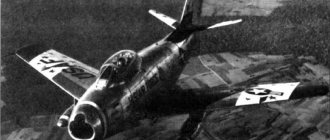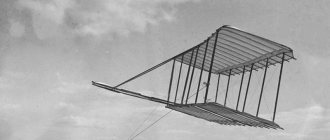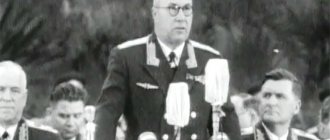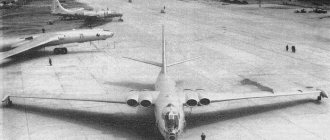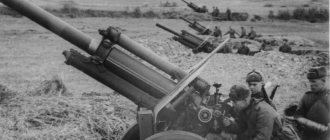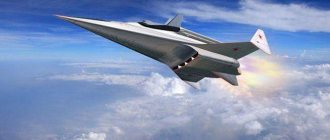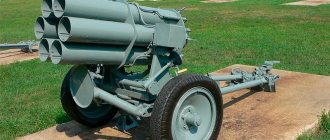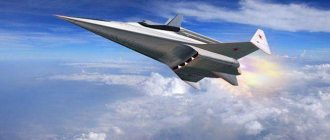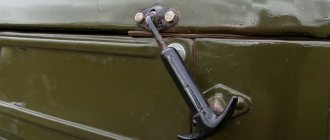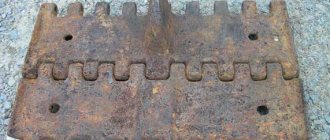History of the creation of the BI-1 interceptor
In the late 1930s and early 1940s, in the Soviet Union, the aviation industry experienced an unprecedented rise - one after another, the latest high-speed fighters, such as the Yak-1 and MiG-3, entered service. However, although the limit of development of piston machines had not yet been passed, the thoughts of the designers were directed far ahead. By the spring of 1940, tests of the serial fighter I-153 with a ramjet engine and the experimental rocket plane RP-318-1 with a liquid rocket engine had already been successfully completed.
Everything was moving towards a natural conclusion - the creation of a combat jet (rocket) aircraft. Since the low weight and high thrust of the jet engine provided not only a maximum horizontal flight speed in the region of 800-850 km/h, but also a high rate of climb - almost 10 times higher than the rate of climb of the best fighters with piston engines, in type, a promising aircraft could only be interceptor fighter. To a large extent, the main disadvantage of the jet engine was the short flight time. For the interceptor, this drawback was not critical.
Although all the leading aircraft designers of the USSR showed interest in a fundamentally new aircraft, among the first was the experimental design bureau of Viktor Fedorovich Bolkhovitinov , created at Plant 293 on the initiative of the Air Force Academy named after N. E. Zhukovsky, and engaged in the design of fundamentally new types of aircraft.
As soon as all the conditions for the future rocket plane were formulated, two designers of this design bureau, aerodynamicist A. Ya. Bereznyak and engine designer A. M. Isaev, proactively began work on the project of a fighter-interceptor with an engine designed by Leonid Stepanovich Dushkin, who headed the “LPRE group” at NII-3, better known as the Rocket Scientific Research Institute (RNII). The latest and simplest of their projects received approval from the chief designer and was included in the work plan, but on an optional basis, in April 1941. The team received a separate room, and the project itself received the official name “ BI ” - after the first letters of the surnames of the designers Bereznyak and Isaev.
General diagram of the BI-1 jet fighter
What are the lyrics of the song “Pilot” about?
There are situations in every person’s life when everything gets out of control, although initially it seemed that everything was thoroughly calculated. Mistakes, even small ones, lead to catastrophic consequences. This idea of the song “Bi-2” is immediately noticeable. If you listen closely, you will be greeted by an amazing discovery: modern Russian rock music has not lost its rebellious spirit, having slipped downhill from pop music.
A leisurely ri, as if following the beat of the pulse, a clear pronunciation of phrases, like the announcement of a death sentence for the doomed. Nothing is important anymore, and the result of the efforts, as it turned out, was not worth spending your life on.
The alarming and viscous melody of the composition “Pilot”, behind which at the beginning one can discern the roar of fighter jets, dripping water and metallic grinding, increases the tension of the listeners. analogies with military events occurring throughout the planet are inevitable. This is a debilitating burden for all of humanity, and people are dying for metal and hydrocarbon deposits.
There is no end in sight to this. The song “Pilot” calls on you to share the pain of what is happening with the Bi-2 group. Aren’t the normal part of “homo sapiens” tired of obeying the orders of those who organize their own personal luxury holiday and dolce vita at someone else’s expense, raking in the heat with someone else’s hands?
Design of the BI-1 interceptor
The BI-1 jet interceptor was a single-seat cantilever low-wing aircraft with a semi-monocoque fuselage, mainly of wooden construction. The trapezoidal one-piece wing of the BI aircraft had a caisson-type structure. The caisson consisted of ten separate spars, glued together through linings running along the entire span of the wing - along the upper and lower theoretical contours.
To reduce the landing speed, Schrenk landing flaps with a deflection angle of up to 50 degrees were installed on the trailing edge of the wing in the area between the side of the fuselage and a small aileron, equal in length to about a third of the wing. The ailerons, rudders and flaps had a metal frame covered with fabric.
The tail of the aircraft is of the usual type, but with three features: braces are installed between the fin, stabilizer and fuselage, there are round vertical washers at the ends of the stabilizer, and a ventral fin-fin is installed into which the tail support of the aircraft landing gear is retracted.
The pilot's cockpit had protection consisting of a front armor plate, a 5.5 mm thick armored back and armored glass. In front of the pilot's cabin in the upper part of the fuselage, two ShVAK 20 mm cannons with 45 rounds of ammunition were installed on a wooden carriage under a removable (locked) cover. Inside the lower front part of the fuselage there were two air and two kerosene cylinders. Cylinders with nitric acid and air were located behind the cockpit.
The liquid jet engine LRDD-1-A-1100 is installed in the rear part of the fuselage; tractor kerosene was used as fuel, and concentrated 96-98% nitric acid was used as an oxidizer, which were supplied to the engine under air pressure from on-board cylinders ( per 1 kg of kerosene there were 4.2 kg of oxidizing agent). The engine consumed up to 6 kg of kerosene and acid per second at maximum thrust. The total fuel supply on board the aircraft, equal to 705 kg, ensured engine operation for almost 4 minutes (at maximum thrust).
Characteristics of BI-1 (BI, BI-VS)
A country:USSRType:Missile interceptorYear of issue:1942Crew:1 personEngine:1x LPRE-1-A-100, power 1100 kgfMaximum speed:800 km/h at the ground, up to 1020 km/h at an altitude of 7000 mPractical ceiling:No informationRange of flight:No informationEmpty weight:790 kgMaximum take-off weight:1650 kgWingspan:6.48 mLength:6.40 mHeight:2.06 mWing area:7 sq. m Weapons:2x 20-mm ShVAK cannons (45 rounds per barrel) BEYAMNI 1940 Ts. B YANYARNKNYAE YANBEYYUMKHE, MU YNRNPNL TSKYUBMSHE YNMYARPSYRNPSH YAYULNKERNB ASHKKH OPNKHMTNPLHPNBYUMSH N MNBSHU OEPYAOEIRKHBMSHU YAHKNBSHU SYARYUMNBYUU YA PE YURHBMSHLH DBKHTSUREKLH PUGKHVMSHU RHONB, B NYAMNBMNL I fpd X obpd. 12 KhChK 1940 Ts. HBMSHHLH DBHTSUREKLH. b ONYARYUMNBKEMKHKH, B VYUYARMNYARKH, OPEDSYALYURPHBYUKNYAE PEYEMKHE BNOPNYANB “N OPHLEMEMKHH PEYUYRKHBMSHU DBKHTSUREKEY ANKENI LNYMNYARKH DK YABEPUYAYNPNYARMSHU YARPURNYATEPMSHU O NKERNB..."
b RNL FE 1940 C. ASHKYU OPHGMYUMYU MENAUNDHLNYARE YANGDYUMH HYARPEAHREK-OEPEUBYURVHYU I fpd. хDECH YANGDIUMKH RUYNTSN KHYARPEAHREK BOEPBSHE OPEDKNFHK I. O. yNPNKEB EYE B 1938 C. B OPNZHEAYAYE PUANRSH MYUD PUYERNOKUMNL po-218. nM OPEDONKYUTSYUK, VRN fpd I ETSN NTSPNLMSHL SDEKEMSHL PUYAUNDNL RNOXBYU (4-6YYTs RNOXBYU B YAYSMDS OPH RJCE DBKHTSUREK 1000 - 1500 YTSYA) LNFER ASHRE MUHANKEE SCHTTEYRKH BMN HYAONKEGNBYUM MU KHYARPEAHREKE-OEPEUBYURVHYE OPNRKHBNBNGDSSMNI NANPNMSH, BGKERYUCHYEL HG ONKNFEMKH DEFSPYARBU MU YUSCHPNDPNLE OPH BHGSYUKEMNL NAMYUPSFEMXX YAYULNKERYU OPNRKH BMHYU B PYYINME NUPYUMYELNTSN NAZEIRIU. LUKSHI BEYA X ANKEYU ROTSYU fpd NAEYAOEVKHBUKH LYYYAHLYUKEMSCH YAYNPNYARE TsNPKHGNMRYUKEMNTSN ONKERYU PUYERMNTSN OPEUBYURVHYU 800 - 850 YL/V. MN YAYULNE TSKYUBMNE, RYYNI OEPEUBYURVHY HLEK ASH TSPNLYUDMSCH ON RNLS BPELEMH YAYNPNONDZELMNYARE, ONVRH B 10 PYUG OPEBSHYUBSCH YAYNPNONDZELMNYARE KSVIKHU HYARPEAHREKEY I ONPMEB SHLH DBHTSUREKLH. AKYUTSNDYUP ANKENI YAYNPNYARKH YAYNPNONDZELMNYARKH PUYERMSHI OEPEUBYURVKHY MU YUYRKHBMNL ShRYUOE ONKERYA PUANRYUCHYHL fpd LNTs AS ASHIARPN MYUYARKHTSMSRE YAYULNKER OPNRKHBMKHYU, I UNDS YURYUNBURE ETSN X YAAKHRE LNYMSHL OSEVMSHL NTSML. ONYAKE OPEYYYYEMH PUANRSH DBKHTSUREK OEPEUBUYURVKHY DNAFEM ASHK BSHIRKH HG ANЪ X BSHONKMKHRE ONYUDYS I MEPUANRYUCHIHL DBKHTSUREKEL YUY OKUMEP, VRN ME DNAFMN ASHKN OPEDYARYUBH RE RPSDMNYARKH, SVKHRSHBYU GMYUVKHREKEMNE SLEMEEMHE LYUYAYASH YYULNKERYU ONYAKE BSHPUANRYKH RNOXBYU X KHGPYUYAUNDNBYUMKH ANEGYUOYUYU. nYAMNBMSHL MEDNYARYURYNL RUYNTSN YYULNKERY I. O. yNPNKEB YAVHRYUK LUXCH OPNDNKFHREKEMNYARE ONKERYU. bNEMMSHE YAOJHYUKHYARSH ONKNFHREKEMN NZHEMHKH OPEKNFEMHE I. O. yNPNKEBYU KH B YABNEL GUYKCHVEMKHH ONDVEPYKHBUKH, VRN MEANKEYU OPNDNKFHREKEMNYARE ONKERYU DNOSYAYUER OPYURKHVEYAYINE HYAONKEGNBYUMHE RYUKHU YYULNKERNB.
i BEYAMSH 1941 Ts. 00 YL/V X ANKEE, B KHMKHZHYURKHBMNL ONP'DYE MYUVYUKH PUANRYURE y.b.aEPEGMYY X y.l .xYAYUB. yNMZHEOZHKH PUYERMNTSN OEPEUBYURVKHYU OPYURKHVEYAYKH ONKMNNYARECH YANNRBERYARBNBUKYU OPEDKNFEMHCH I. O. yNPNKEBU, BSHDBHMSRNLS B 1938 C.
9 KhChM 1941 Ts. HYARPEAHREK-OEPEUBYURVHYU ah
. oPEDKNFEMKHE ASHKN NDNAPEMN, OPKHMIRN, MU ETSN NYAMNBE ASHK SRNVMEM OPHYUG ON myyuo. JAPNY BSHOSYAYU ASHK SYARYUMNBKEM 35 DMEI (BLEYARN RPEU LEYAZHEB, YUY OPEDONKYUTSYUKH YNMYARPSYRNPSH).
YaYULNKER yu.b.aEPEGMYYU X y.l.xYAYUEBY OEPBNMYUVYUKEMN OPNEIRKHPPNBUKYA OND DBKHTSUREKE I RTsNI 1400 YTSYA X I RSPANMYYANYAMNI ONDUVEI RNOXBYU B YULEPS YATSNPYUMKH, MN GUREL I ZHEKECH YANYPYUYYEMH BPELEMKH YANGYUMH YAYULNKERYU ANKEE YAKNFMYU H MSFDYUBYUBYYYA B DNBNDYE RSPANMYUYANYAMYU ONDUVYU RNKOKHBU ASHKYU GYULEMEMYU ANKEE OPNYARNI X DNBEDEMMNI BSHREYAMHREKEMNI ONDUVEI I HYAONKEGNBUMHEL YAFYURNTSN DN 145-148 YURL BNGDSUYU HG ANPRNBSHU AYUKKNMNB ELINYARECH 115 K. schRNR BYUPHYUMR YAYULNKERYU I DBKHTSUREKEL d-1 yu YARYUK NYAMNBMSHL X ONKSVHK NANGMYUVEMHE “ah”; NM BSHONKMKYA OH NASHVMNI B RN BPEL YAUELE NDMNLEYARMNTSN YABNANDMNMEYASYYETSN MKHGYNOKYUMYU B NYAMNBMNL DEPEBMMNI YNMYARPSYZHHH.
rPYUOEZHHEBKHDMNE MEPUGZELMNE OPOLNE YPSHKN YAYULNKERYU “ah” HLEKN YNMYARPSYZHCH YEYAYANMMNTSN RHOYU. YEYAYANM YANYARNK HG DEYARKH NRDEKEMSHU KNMFEPNMNB, YAYKEEMMSHU LEFDS YANANI VEPEG MYYKUDYKH, KHDSYKHE ON BIAELS PYUGLUUS YPSHKYU - ON BEPUMELS X MHFMELS RENPERHVEYAINLS YNMRSPS. dK SLEMEYEMKH ONYYUDNVMNI YAYNPNYARKH MU GYUDMEI YPNLYE YPSHKYU MU SVIYARYE LEFDS ANPRNL TCHGEKKFYU H MEANKEHL SCHKEPNMNL SYARYUMYUBKHBYUKHYAE ONYUDNVMSHE YKHRY H PEMYU I STSKNL NRYKNMEMKH 50╟. UBNYARNBNE NOEPEMKHE YYULNKERYU - NASHVMNTSN RHOYU, MN I RPEL NYNAEMNYARLH: PYYAVYUKYKH LEFDS YHKEL, YARYUAHKHKHYURNPNL H TCHGEKFEL; YPSTSKSHE BEPRKHYUKEMSHE YUIASH MU YNMZHYU YARYUAHKKHGYURNPYU, ONDTCHGEKFMSHI YHKE, B YNRNPSHI SAKHPYUKYUYAE UBNYARNBYU NONPU YUYAYAH YYULNKERYU. yuIASH MU YNMZHYU YARYUAHKHKYURNPYU ASHKH SYARYUMNBKEMSH SFE ONYAKE ONYARPNIIKH NOSHRMNTSN YYULNKERYU B OPNZHEYAYAYE YUSCHPNDKHMYULHVEYAYKHU KERMSHU KHYADSHRYUMKHI ON OPEDCNFEMKHCH x. t. tKNPNBU. schKEPNMSH, PSKH X GYIPSHKYKH HLEKH LERYUKKKHVEYAYHI YUPYYUYA, NAHRSHI ONKNRMNL (PHYA. 3).
tCHGEKЪF YAYULNKERYU “ah” - DEPEBMMSHY ONKSLNMNYNYY. yYUAHMYU KERVHYU HLEKYU APNMEGYUYHRS XG OEPEDMEI APNMEOKHRSH X APNMEYAOKHMYKH RNKYKHMNI 5.5 LL. OEPED YYUAKHMNI KERVKHYU B BEPUMEI VYUYARKH TCHGEKKFYU MU DEPEBMMNL KYUTERE SYARYUMYUBKHBYUKKHYAE DBE OSYKH BYU YYUKHAPIU 20LL I ANEGUOYUYANL ON 45 YAMYUPDNB. bMSRPKH MHFMEI OPEDMEI VYUYARKH TCHGEKKFYU PUYAONKYUTSYUKHYAE DBY BNGDSMSHU X DBY YEPNYAHMNBSHU AYUKKNMYU. gyu YYUAKHMNI KERVKHYU PYUGLEYYUKKHYAE AYUKKNMSH I YUGNRMNI YHYAKNRNI KH BNGDSUNL.
fpd d-1yu-1100 SYARYUMYUBKHBYUKYA B UBNYARNBNI VYUARKH TCHGEKFYU. rNOKKHBN - RPYURNPMSHI YEPNYAHM, YU B YUVEYARBE NYHYAKHREK OPHLEMKYUYAE YNMZHEMRPKHPPNBUMMYU 96-98%-MU YUGNRMYU YHYAKNRYU, YNRNPSH ONYUBYUKHYAE B DBKHTS YUREKE OND DYUBKEMKHEL BNGDSUYU HG ANPRNBSHU AYUKKNMNB (MU 1 YTS YEPNYAKHMYU OPHUNDHKNYAE 4.2YTS NYHYAKHREK). dBHTSUREKE PUYAUNDNBYUK 6YTS YEPNYAHMYU H YHYAKNRSH B YAEYSMDS. NAYKHI GYUOYUYA RNOKKHBYU MU ANPRS YAYULNKERYU, PYUBMSHI 705 YTS, NAEYAOEVKHBYUK PUANRS DBKHTSUREK B REVEMKHE ONVRKH 2 LHM. pyuYAVERMYU BGKERMYU LYUYAYU YYULNKERYU “ah” YANYARYUBKYU 1650 YTS OPH LYUYAYAYE OSYARNTsN 805 YTS.
YaRPNHKH YAYULNKER ONVRH AEG DERYUKEMSHU VEPREFEY, BSHVEPVHBYU B MURSPS MU TYUMPE ETSN VYUARKH, ON OKYUGYUL. shRN NAKETSVYUKNYAE LYUKSHLH PUGLEPYULH YAYULNKERYU. nayye YNMYARPSYRKHBMNE KH OPNKHGBNDYARBEMMNE HYAONKMEMHE ASHKN YAPEDMEE, BYARPEVIUKHYAE KH MEOPNVMSHE LEYARYU (KH-GYU YAOEYH).
15 YAEMRIAP 1941 Ts. OKUMEP OEPBNTSN NOSHRMNTSN YAYULNKERYU “ah” ASHK ONYARPNEM. ndMUYN DBHTSYUREKE YAYULNKERYU EYE ME ASHK TsNRNB, OPNBNDHKYUYAE ETSN YAREMDNBYU DNBNDYU. ON RPEANBYUMKHCH GYULEYARKHREK MYUPYNLYU YUBHYUZHNMMNI OPNLSHKEMNYARH ON NOSHRMNLS YYULNKERNYARPNEMKHCH yu.ya.YINBKEBYU, OKUMEP YYULNKERYU “ah” ASHK ONDTSNRNBKEM Y HYAKEDNBYU MHЪL B MYURSPMNI YUSCHPNDKHMYULKHVEYAYNI RPSAE zhyutskh. oPNDSBYH "ah" OPNBNDHKHYAE OND PSYNBNDYARBNL ts. I. aCHEMYU X yu. k. pYIYUYU. yaPYUGS ONYAKE GYUBEPYEMKH YUSCHPNDHMYULHVEYAYHU HYAYAKEDNBYUMHI MYVYUKHYAE KERMSHE HYAOSHRYUMH YYULNKERYU “ah” B OKYUMEPMNL BYUPHYUMRE MU ASYAHPE GYU YYULNKERNL oE-2. KERVKHY a.m.ySDPHM B 15 ONKERYUU YAMK BYAE NYAMNBMSHE KERMSHE UYUPYUREPHYARKHYH “ah” MY LYUKSHU YAYNPNYARU. hYAOSHRYUMH ONDRBEPDHKH, VRN BYA YUSCHPNDHMYULHVEYAYHE DUMMSHE YYULNKERYU, UYUPYUREPHYARKHYH SARNIVKHBNYARKH SOYUBKELNYARH YANNRBERYARBSCHR PUYAVERMSHL. nDMNBPELEMMN I HYAOSHRYUMHLH OKYUMEPYU "ah" DNBNDHKYA KH DBHTSYUREKE (MYUDEFMNYARE YAHYARELSH ETSN GYUOSYAYU).
b NYRJAPE 1941 Ts. TSYUREK. th BEYAME 1942 Ts. NYAMNBMSHE RPSDMNYARKH ASHKKH OPENDNKEMSH, KH DBKHTSUREKE SYARYUMNBHKH MU YAYULNKER. dK OEPBNTSN ONKERYU KHYARPEAHREK "ah" (HMNTsDU NANGMYUVYUBETSNNYA YUY ah-1) ASHKYU YANGDUMYU TSNYASDYUPYARBEMMYU YNLHYAYAKH OND OPEDAEDYUREKEYARBNL b. I. OSHMNBU. b YNLHYAYAKHCH BNKKH RUYFE b. t. anNKUNBHRKHMNB, MYUVYUKEMHY mxx bbya o. X. TEDNPNB, BEDSYKHI HMFEMEP ON YAYULNKERS “ah” NR mxx bbya l. X. rYUPYYUMNBAYKHI, BEDSYKHI KHMFEMEP ON DBKHTSUREKCH yu.b.oYUKKN. BEDSYHL KERVKHYNL ASHK MYUGMYUVEM KERVKHY-HYAOSHRYUREKE mxx bbya ts.b.aYuUVHBYUMDFH.
oEPBSHI ONKER MU KHYARPEAHREKE "ah" KERVHY ts.b.aYUUVHBYUMDFH BSHONKMHK 15 LYU 1942 Ts. bGKERMYU LYUYAYAYA YYULNKERYU B OEPBNL ONKERE ASHKYU NTsPYUMHVEMYU 1300YTS, YU DBHTSYURE KE NRPETSKHPNBYUM MU RYTSS 800YTSYA. onKER OPNDNKFYUKYA 3 LHM 9 YA YYYULNOHYAZH GYUTHYAKHPNBUKH LYYYAHLYUKEMSCH BSHYANRS ONKERYU 840 L, YAYNPNYARE 400 YL/V, YAYNPNONDZELMNYARE - 23 L/YA. b ONYAKEONKERMNL DNMEYAEMHH KERVHY-HYAOSHRYUREKE NRLEVYUK, VRN ONKER MU YAYULNKERE “ah” B YAPYUBMEMHH I NASHVMSHLH RHOYULH YAYULNKERNB HYAYKCHVHREKEMN OPHJREM: OEPED KERVKHYNL MER BHM RYU X LNRNPYU, ME YAKSHMN SLYU, BSHUKNOMSHE TSYUGSH B YUAHMS ME ONYUDUCHR; KERVKHY, YAHD B OEPEDMEI VYUYARKH YAYULNKERYU, HLEER ONKMSHI NAGNP OEEDMEI ONKSYATEPSH KH MYUVKHREKEMN KSVIKHI, VEL MU NASHVMNL YAYULNKERE, NAGNP GYUDMEI ONKSYATEPSH; PUYAONKNFEMKHE OPKHANPNB KH PSHVYUTSNB SOPYUBKEMKH SDYUVMNE, BKHDHLNYARE KHU UNPNNYU, YUAHMYU ME GYUTSPNLNFDEMYU; OH KETSINYARKH SOPYUBKEMKH YAYULNKER OPEBNYAUNDHR YANBPELEMMSHE ELS HYARPEAHREKH.
ON NZHEMYE TSNYASDYUPYARBEMMNI YNLHYAYAHH, OEPBSHI ONKER "ah" DNYUGYUK BNGLNFMNYARE ONKERNB OPH MNBNL OPKHMZHHOE YANGDYUMKH RYTSKH X NRYPSHK MNBNE MYUOPYUBKEMKHE B PUGBHRHH Yu BHYUZHHH. schRNR ONKER ASHK OEPBSHL B LHPE ONKERNL HYARPEAHREK-OEPEUBYURVHYU I fpd, YAOPNNEIRKHPPNBUMMSHL DK BSHONKMEMH GYUDYUV, OPHYASYKHU SHRNLS YKYUYAYAS YYULNKERNB, X YANNRBER YARBSCHIHL NAPUGNL BNNPSFEMMSHL. gyu PSAEFNL Y LYUCH 1942 Ts. KERYUKH RNKEIN SHYYAOEPHLEMRYUKEMSHE YYULNKERSH I fpd AEG BNNPSFEMKH (uEIMYEKE 176 X DFS 194-OPNRNRKHO PUYERMNTSN KHYARPEAHREK LEYAYEPLHRR 163b, Gloster G.40 (yuМЦКХЪ)).
b YABIGH I HGMNYANL YNMYARPSYZHKH OKYUMEPYU OEPBNTSN NOSHRMNTSN YYULNKERYU (TSKYUBMSHL NAPUGNL NR BNGDEYARBKH OYUPNB YUGNRMNI YHYAKNRSH) ONYAKEDSCHYHE KERMSHE HYAOSHRYUMKH YAYULNKERYU "ah" OPNBNDHKHYAE MU BRNPNL X RPEREEL NOSHRMSHU YAYULNKERYUU, NRKHVYUBHKHYAJ NR OEPBNTN RNNKEIN MYUKHVHEL KSHFMNTSN YUYAYAKH. nDMNBPELEMMN ASHKN OPKHMURN PEYEMKHE MYUVYURE ONYARPNIYS MEANKENNI YAEPHH YYULNKERNB “ah-bya” DK KHU BNIYAYNBSHU HYAOSHRYUMKHI. nR NOSHRMSHU YYULNKERNB "ah-bya" NRKHVYUKHYAE BNNPSFEMHEL: B DNONKMEMKHE Y DBSL OSYUL OND TCHGEKFEL ON OPNDNKEMNI NYAH YYULNKERYU OEPED YUAKHMNI KERVKHYU SYARYUMYUBKHBUKYUYAE ANL ANBU YUYAYAYERYU, GUIPSHRYU NAREYUREKEL. b YYYYAYAYERE PUGLEYYUKNYAE DEYARE LEKYKHU ANLA LYUYAYANI ON 2.5 YTS, NAKYUDYUBKHU ANKENNI BGPSHBMNI YAHKNI. OPEDONKYUTSYUKNYAE, VRN ShchRKH ANLASH ASDSR YAAPYYASHBUREYA MYUD ANLAYUPKHPPNBYKHYULH, KhDSYKHLH B ANEBNL YARPNCH, KH ONPUFYURE KH SDUPMNI BNKMNI KH NYANKYULH.
bRNPNNI ONKER NOSHRMNTSN YAYULNKERYU "ah" YANYARNKYAKYA 10 ЪМБУПЪ 1943 Ts. ъ. aYUUVHBYUMDFH X NDHM KERVKHYNL-HYAOSHRYUREKEL y.yu.tsPSGDEBSHL. b SCHRKHU ONKERYU ASHKH GYUTHYAHPNBYUMSH MYUKHBSHYAKHE KERMSHE ONYUGYUREKH YAYULNKERYU “ah” - LYUYAKHLYUKEMYU YAYNPNYARE DN 675 YL/V, BEPRHYUKEMYU YAYNPNONDZELMNYARE 82 L/Y, BSHIANRYU ONKERYU 4000 L, BPEL ONKERYU 6 LHM 22 YA, OPNDNKFHREKEMNYARE PUANRSH DBKHTSUREK 84 YA. JEYARNI H YAEDELNI ONKERSH BSHONKMKKHYAE ts.aYUUVHBYUMDFH MU RPEREEL NOSHRMNL YAYULNKERE. gYUDYUMKHE KERVHYS MU YAEDELNI ONKER, YANYARNBIKHIYA 27 LYUPRYU 1943 C, OPEDSYALYURPHBYUKN DNBEDEKHE YAYNPNYARKH TsNPKHGNMRYUKEMNTSN ONKERYU YYULNKERYU DN 750 - 800 YL/V ON OPH ANPS MU BSHIANRE 2000 L. ON MYAKCHDEMKHIL I GELKH, YAEDELNI ONKER, BOKNRE DN YNMZHYU PUANRSH DBKHTSUREK MU 78-I YAYSMDE , OPNREYUK MNPLYUKEMN. Onyak Ninmwumh Puyunsherykh Yuulnker, Muundhbhiya B TsNPHGNMRUCEMMNL ONKERA, BNIKHK MNYA, BNEKHPNBUMHA X OND SCKNL NNKNN 50╟ SDUPHKYKYA N GELKCH. yNLHYAYAKH, PUYAYAKEDNBYUBYU NAYARRNЪREKEYARBU YYURYUYARPNTSH, B RN BPEL ME YALNTSKYU SYARYUMNBHRE ONDKKHMMSHE OPHVKHMSH OPEUNDU B OKHIKHPNBYUMKHE YYULNKERYU “ah.” mN B YABNEL GUYKCHVEMKHH NMYu NRLEVYUKYU, VRN EYE ME HGSVEMSH ЪBKEMKHЪ, OPNKHYAUNDYKHE OPH YAYNPNYARU ONKERYU ONPJYU 800 -1000 YL/V. ON LMEMKHCH YNLHYAYAHH, MU SHCHRKHU YAYNPNYARU LNTSKKH ONЪBHREYA MNBSHE TYURNPSH, BNGDEIARBSCHYKHE MU SOPYUBKELNYARE, SARNIVKHBNYARE KH MYUTSPSGYKH MU NPTSYUMSH SOPIUBKEMKH , YNRNPSHE PUYAUNDHKHKHAE I OPKHMURSHLKH B RN BPEL OPEDYARYUBKEMKHLKH, YU YAKEDNBUREKEMN, NYARYUKKHAE MESVREMMSHLKH.
b 1943 Ts. b MEI YAPYUGS FE MYUVYUKH OPNBNDHRE bHPNNYKHE HYAYAKEDNBYUMH LNDEKEY YYULNKERNB X XU SHKELEMRNB OPH ANKEKHU DNGBSYNBSHU YAYNPNYARU. aSHKYU HYAOSHRYUMYU KH LNDEKE YYULNKERYU “ah” DK BSHBBKEMKH OPHVKHM YURYUYARPNTSH. ON PEGSKERYURYUL HYAOSHRYUMKHI YARYUKN YYAMN, VRN “ah” PYUGAKHKYA HG-GYU MESVREMMSHU OPH OPNEIRKHPNBYUMKH YYULNKERYU NYANAYEMMNNYAREI NAREYUMH OPOLNTSN YPSHKYU H NOPEPEMKH MU N YNKNGBSYNBSHU YAYNPNYARU KH BNGMKHYUCHYETSN OPKH ShchRNL ЪBKEMHЪ GYURЪTSKHBYUMKH YAYULNKERYU B OKHYKHPNBYUMKHE, OPENDNKERE YNRNPNE KERVKHY ME LNTs.
onyake Tskhaekkh ts.ayuuvkhbyumdfkh mednyarpnemmshe 30 - 40 YYULNKERNB “ah-bya” ASHKH SMHVRNFEMSH, MN PUANRSH ON SRNI RELAY OPNDNKFYUKHYAE EY MEINRNPNE BPEL.
I ZHEKECH KHGSVEMHYARKH SBEKHVEMHYU OPNDNKFHREKEMNYARKH ONKERYU PUYERMNTSN HYARPEAHREK-OEPEUBYURVHYU RHOYU "ah" B 1943-1944 CC. PYYYAYALYURPHBYUKYUYAE LNDKHTHYUZHKH SHRNTSN YYULNKERYU I OPLNRNVMSHLKH BNGDSMN-PEYUYRKHBMSHHLKH DBKHTSUREKLKH MU YNMZHYUU YPSHKYU. nMYu ASHKYU HYAYAKEDNBYUYU B YUSCHPNDKHMYULKHVEYAYNI RPSAE zhyutskh, MN DUKEMEYETSN PUGBHRHKYU ME ONKSVKHKYU. b ЪМБУПЭ 1945 Ts. MU YAYULNKERE “ah” I KSHFMSHL YUYAYAH KH DBKHTSYUREKEL pd-1 yu.l.xYAYUEBYU, ЪBКББХЛЯ ПУГБХРХЛ DBХЦУРКЪ d-1yu-1100, KERVKHY a.m.ySDPHM BSHONKM HC DBY ONKERU. b NDMNL KH SHCHRKHU ONKERNB OPH BGKERMNI LYUYAYAYE YYULNKERYU 1800YTS X YAYNPNYARH 587 YL/V BEPRKHYUKEMYU YAYNPNYARE “ah” S GELKH YANYARYUBKHKYU 87 L/YA. nDMMUYN GYUREL PUANRSH MYUD YAYULNKERNL OPEYYURKHKH. dK OPNBEDEMKH PUGKKHVMSHU HYAOSHRYUMKHI ASHKN ONYARPNEMN DEBRE YYULNKERNB “ah.” cru:
| lNDHTHYUZHH | Oh |
| pYUGLUU YPSHKYU, L | 6.48 |
| dKKhMYu, L | 6.40 |
| bSHYANRYU, L | 2.06 |
| OKNYYUDE YPSHKYU, L2 | 7.00 |
| I love it, JC | |
| OSYARNTSN YYULNKERYU | 790 |
| BGKERMYU | 1683 |
| RHO DBKHTSUREK | 1 fpd d-1yu |
| rtsyu, ytsya | 1 U 1100 |
| LYUYAKHLYUKEMYYAINPNYARE, YL/V | |
| WITH GELKH | 800 |
| MU BSHIANRE | 1020 |
| oPNDNKFHREKEMNYARE ONKERU, LHM | 15 |
| LYUYAKHLYUKEMYYAINNONDZELMNYARE, L/LHM | 10000 |
| oPUYIRKHVEYAYKHI ONRNNKNY, L | |
| schYHOYUF | 1 |
| bNNPSPHEMHE: | DBE 20-LL OSYH BUY |
| bottom. KhMTNPLYUZHKH: |
| vEPREF «aEPEGMYY, xYAYUEB ah (1) » VEPREF « | ah-1 |
| ah-1 | |
| ah-1 | |
| ah-5 | |
| ah-5 | |
| ah-5 | |
| ah-6 | |
| sYARYUMNBYU AXIS BUY MU AH-1 | |
| oPKHANPMYU DAY AH-6 |
IWELSH:
| ah-6 |
| YNLONMNBNVMYU YAUELYU |
bYUPHYUMRSH NYPYYAYH:
| ah-5 |
| YaOHYANY HYARNVMKHYNB: |
| yuBPNB b.a. KHYARNPKH YNMYARPSYZHHI YAYULNKERNB B yayap 1938-1950 CC. pNYARHYAKYUB bKhMNTsPYUDNB, UKEYYYUMDP oNMNLUPEB. pYUGBHRKHE YYULNKERNB LHPYU YAHLYUNB a.k. YaYULNKERSH YARPIUMSH YANBERNB. 1917-1970 YaYULNKERSH YARPIUMSH YANBURNB AirMagazine. Mikhail Maslov. Le chasseur-fusee BI Y. Gordon, B. Gunston. Soviet X-Plane Prototypes.com. Les avions-fusee Russes. Le Bereznyak-Isayev BI |
sTSNKNY MEAYU. 2004
Tests of the BI-1 interceptor
On June 22, 1941, V. F. Bolkhovitinov sent an official application to the People's Commissariat of the Aviation Industry for the creation of a missile fighter-interceptor BI. From that moment on, all other design bureau projects were discontinued, since the front needed combat aircraft as soon as possible, and the BI looked the most promising.
The preliminary design was completed in 12 days and already on July 9, a detailed letter was sent to the State Defense Committee, signed by seven project participants - designers and engineers. On August 1, 1941, after receiving the development team in the Kremlin, the State Defense Committee (GKO) by a special resolution ordered V.F. Bolkhovitinov to build and test a jet fighter-interceptor. People's Commissar of the Aviation Industry A.I. Shakhurin and his deputy for experimental aircraft construction A.S. Yakovlev prepared a detailed order, which allocated only 35 days for the construction of an aircraft for flight testing, even despite the lack of drawings. And yet, on September 15, 1941, with a delay of only 5 days, the airframe of the first experimental aircraft “BI-1” was prepared for research in the TsAGI wind tunnel.
The engine for the BI-1 was as revolutionary as the very idea of a rocket plane. Compared to previous designs, it had a tenfold increase in power and was called “ D-1-A-1100 ” (the first nitrate engine with a nominal thrust of 1100 kg). Its design used displacement fuel supply, the role of which was played by nitric acid and kerosene, it had a deep range of thrust control, and most importantly, it was reusable.
Tests of the aircraft in the glider version (towed behind the Pe-2 bomber ) were successfully completed. The war was already in full swing, and almost all the test pilots from the “rocket-plane group” managed to get to the front, but the command and leadership of the NKAP, encouraged by the successes, began a hasty recall. It seemed that there was one more push left and... the evacuation of factories and design bureaus from near Moscow began, it was October 16, 1941.
BI-1 on a ski chassis, front view
Finding themselves in the village of Bilimbay, 60 kilometers from Sverdlovsk, the design bureau at first had to think not about their plane, but about how to at least heat the workshops of an abandoned foundry that they had inherited. Frosts and shortages of literally everything slowed down the fine-tuning and debugging of the propulsion system, and yet, despite everything, by the end of January 1942, work continued. By April 1942, the D-1-A-1100 engine was brought to working condition and installed on the aircraft.
On April 25, 1942, BI-1 was sent to the airfield in Koltsovo, on April 27, the first test of engine operation on the aircraft took place, and on April 30, G. Ya. Bakhchivandzhi, together with A. V. Pallo, began to start the engine from the cockpit. The first flight of the BI-1 fighter was scheduled for 12 noon on May 15, 1942.
The plane took off into the air, and after 3 minutes 09 seconds, having completed the minimum program, it again appeared above the runway. The landing turned out to be hard, one of the landing gear broke during landing, however, the first flight of the BI-1 was successfully completed. It is not for nothing that the chairman of the state commission for the first flight of BI-1, V. S. Pyshnov, summing up the tests, said that this flight opened the era of jet aviation. BI-1 was indeed the first combat fighter with a liquid jet engine to fully pass State tests. Foreign experiments, by that time, were still experiments (formally the Me-262 was “older” than the BI-1, but in 1942, it didn’t even have a ready engine yet!) - their promising machines flew, in most cases, without weapons, and it was too early to test them seriously.
In the flight report, the test pilot is exceptionally pleasant in comparison with conventional types of aircraft: there is no propeller and motor in front of the pilot, no noise is heard, no exhaust gases enter the cabin; the pilot, sitting in the front of the aircraft, has a full view of the front hemisphere and a much better view of the rear hemisphere than on a conventional aircraft; the arrangement of instruments and control levers is good, their visibility is good, the cabin is not cluttered; In terms of ease of control, the aircraft is superior to its contemporary fighters.”
BI-1 fighter model
Interceptor fighter
Bereznyak, Isaev
The BI aircraft (BI-1) (Bereznyak and Isaev) is an experimental fighter-interceptor with a liquid-propellant rocket engine. The aircraft had unusually small dimensions: a wingspan of 6.48 m, a length of 6.4 m and a wing area of only 7.0 m². Armament: two ShVAK-20 cannons with 90 shells and 38 kg of bombs. Engine D-1 A-1100 by Leonid Stepanovich Dushkin and Vladimir Arkadyevich Shtokolov with a thrust of 1100 kgf practically achieved by this time.
The designers of the BI aircraft are engineers Alexander Yakovlevich Bereznyak and Alexey Mikhailovich Isaev, employees of the V.F. Design Bureau. Bolkhovitinov. Bereznyak was the head of the machinery brigade, Isaev was the head of the engines. In the early spring of 1941, on their own initiative, they began developing a preliminary design for a new type of fighter with a liquid-propellant rocket engine, which promised a speed of 800 km/h or more.
With the beginning of the floodplain, they invited Bolkhovitinov to submit a draft resolution. A letter was sent from the institute (where the engines were made) and the plant, which was signed by seven participants, including the aircraft designers Bereznyak and Isaev, the engine designer Dushkin, the director of the plant Bolkhovitinov and the chief engineer of the institute Kostikov. The letter was sent on July 9, 1941, and soon everyone was summoned to the Kremlin. The proposal was approved, accepted, A.I. Shakhuripym and A.S. Yakovlev drew up a draft resolution, which was approved a few days later. On its basis, an updated order on the NKAP was issued. The release period was set at 35 days (instead of three months, as A. Ya. Bereznyak and A. M. Isaev wanted).
The entire Bolkhovitinov Design Bureau was declared “in barracks condition”; they worked without leaving the plant for a month and ten days. By September 1, the first copy of the aircraft was sent for testing to the NKAP. They built the plane almost without detailed working drawings, drawing its parts in real life on plywood, in plazas. This was made easier by the small size of the aircraft. Purges were made in the full-scale TsAGI pipe (leader G.S. Byushgens).
Aircraft design
- solid wood. The fuselage is a plywood monocoque covered with canvas. The wing is multi-spar with plywood covering, the tail is also made of 2 mm plywood. Rudders and ailerons with fabric covering. Cylinder tanks are welded from chromansil. The engine is in the extreme rear part of the fuselage. Landing gear with small wheels - 500X150 mm, pneumatically retracted into the wing in the direction of the aircraft axis. In practice, the tests were carried out largely in winter - on skis that were retracted. The wing is a caisson type - between two box-shaped spars there is a continuous thick load-bearing skin formed by the flanges of a dozen intermediate lighter spars. Schrenk landing flaps, lowered by 50°, and very small ailerons - only 1/3 of the half-span of the wing. The tail unit is normal, the stabilizer is braced to the fuselage and fin. During purging, small round “washers” of the vertical tail were added to it. The crutch is non-orientable, in a fairing.
The overall design and production performance was average, and there were some weak spots (due to haste).
Empty weight of the experimental BI-1 aircraft - 790 kg, military series - 805 kg Airframe weight - 462 kg, including: fuselage - 182 kg, wing - 174 kg, tail - 30 kg, landing gear - 60 kg, controls - 16 kg; engine weight - 48 kg.
The fuselage contained tanks for compressed air weighing 22.4 kg, tanks for kerosene weighing 31.2 kg and tanks for nitric acid - about 80 kg. The weight of various equipment is about 20 kg.
ShVAK-20 cannons (with 45 shells each) were installed in the forward part of the fuselage under a removable (locked) cover. The aircraft's armament was a full-fledged fighter: it had electrical fire control, pneumatic reloading, and a cassette for small bombs with a total weight of up to 38.4 kg. Weapon weight - 76 kg, armored glass - 6 kg.
Full load - 860 kg, including: pilot - 90 kg, acid - 570 kg, kerosene - 135 kg, ammunition - 19.6 kg, bomb load - 38.4 kg.
The take-off weight of the first experimental aircraft is 1650 kg, the military aircraft is 1683 kg.
Destructive overload 9, with a mass of 1100 kg (with consumption of part of the fuel) - 13.5.
At the airfield, runs and towed approaches began first, while the power plant was still being tested. There were many novelties and difficulties, especially with nitric acid corroding the tanks and wiring. A number of safety measures were required because even nitric acid vapors were harmful to humans, and there were cases of burns. But we managed to more or less cope with this.
A plane without an engine was tested by Boris Nikolaevich Kudrin. In 15 flights all characteristics were taken. Before the evacuation on October 16, 1941, more could not be done. When everything was relocated to the Urals, test pilot Grigory Yakovlevich Bakhchivandzhi was assigned to the plane with the engine installed on it. B. N. Kudrin was hampered by illness. After complete adjustment of the power plant and other modifications, it was possible to begin flights with the engine (it was received in April 1942). The engine test on the plane took place on April 27.
On May 15, 1942, Captain Bakhchivandzhi (a famous front-line pilot who had already worked as a test pilot before the war) performed the first flight on the BI-1. In the winter of 1942, one flight on the BI-1 was performed by Lieutenant Colonel Konstantin Afanasyevich Gruzdev, an outstanding front-line pilot. In this flight, when extending the landing gear before landing, one ski came off, but Gruzdev landed the plane safely.
The flight data was: maximum speed - about 800 km/h (estimated 1020 km/h at an altitude of 10,000 m), rate of climb at the ground - up to 82 m/s, flight time - 7 minutes, take-off run - about 400 m, climb time 5000 m - 30 s, acceleration to a speed of 800 km/h - 20 s, landing speed - 143 km/h.
The flight on the BI-1 was difficult, and not only because of unfamiliarity. It was possible to sit on it only after running out of fuel; it was unpleasant to be in the vicinity of nitric acid under high pressure, which sometimes burst out through the joints of the wiring, and even through the walls of pipes and tanks. These damages had to be repaired all the time, which greatly delayed the flights, which continued throughout the winter of 1942-1943. In the course of them, G. Ya. Bakhchivandzhi died on March 27, 1943, when the plane went into a dive from a horizontal flight, from which it could not recover. The reason became clear only later. The fault was the straight (non-swept) wing, which has the inherent effect of being pulled into a dive at speeds of 900 km/h or more.
A military series of eight BI-1 aircraft was built (they were also called BI-2). B.N. Kudrin flew on one of them upon his return to Moscow; there were no more flights. There was an attempt - unfinished - to make the cabin airtight on one of the aircraft by covering all the seams with rubber strips.
It soon became clear that the BI aircraft could not be accepted as a fighter due to the excessively short flight duration, which was not covered by the one and a half times superiority in speed. The BI aircraft served to accumulate experience in this kind of work - in other projects of fighter jets with liquid-propellant engines and in installations of liquid-propellant rocket engines on piston aircraft as temporary flight boosters.
In 1948-1949 A. Ya. Bereznyak had a project for an interceptor fighter with a three-chamber liquid-propellant rocket engine (his own) with a thrust of 10 tons plus an AM-5 engine with a thrust of 2 tons for returning to the airfield and landing. A speed corresponding to 1.8 M was expected. The climb time was 20 km in 20 minutes and the range was 750 km.
The project was not implemented.
Characteristics of BI-1
| Crew, people | 1 person | |
| Dimensions. | ||
| Wingspan, m | 6,48 | |
| Wing area, m2 | 7,0 | |
| Aircraft length, m | 6,4 | |
| Engine. | ||
| D-1 A-1100, thrust | 1100 kg | |
| Weights and loads, kg: | ||
| Empty plane | 790 | |
| Take-off | 1650 | |
| Flight data. | ||
| Maximum speed, km/h | more | 800 |
| calculated | 1020 | |
| at a height of m | 10000 | |
| Acceleration time to 800 km/h, sec | 20 | |
| Landing speed, km/h | 143 | |
| Rate of climb at the ground, m/sec | 82 | |
| Time to climb 5000 m, sec | 30 | |
| Armament | ||
| 2 ShVAK-20 cannons, pcs. | 2Х45 | |
Date of publication on the website: 08/13/2011
